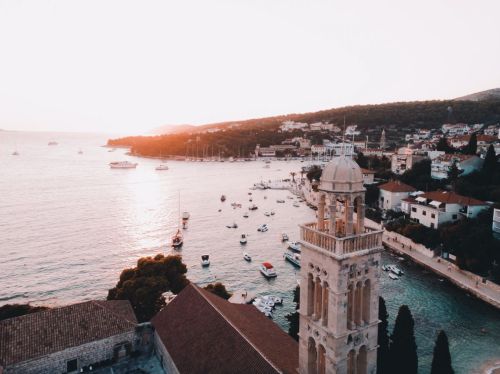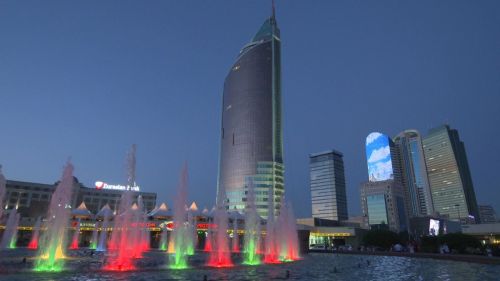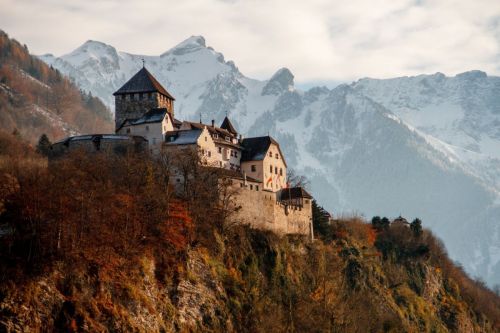Switzerland is one of the most interesting countries. It is a small landlocked country at the junction of Western, Central, and Southern Europe, associated mainly with banks, famous red pocket knives, Swiss watches, cheese, and ski resorts in the sky-high Alps. Switzerland is the crossroads of Germanic and Romance Europe, which is reflected in its four main linguistic regions. Although the majority of the population is German-speaking, the Swiss national identity is rooted in shared history, values, and Alpine symbolism.
Since there is no single division of Europe accepted by all, some, such as the UN and National Geographic, classify Switzerland as Western Europe (in geopolitical terms), while others treat it as a Central European country. Moreover, Switzerland also belongs to the region called Mitteleuropa ("Central Europe") - this is not only geographical but also cultural and political.
Its area is 41.277 square kilometers, of which 39.997 square kilometers is land and 1280 square kilometers is water. The country's length from north to south is 220 km and from east to west 350 km.
In the east with Austria and Liechtenstein, in the west with France, in the south with Italy, and the north with Germany.
It is an Alpine country - 60% of the country's area is covered by the Alps.
Bern is the fourth largest and most populous city in Switzerland, the seat of government, and the capital of the canton of Bern. The city was founded in 1191 by Berthold V, Duke of Zähringen, and according to legend, he named it Bern (bear) because he killed a bear there while hunting. Today, the bear is included in the city's coat of arms and is the city's mascot. The city lies on the Aare River, which divides it into two parts connected by bridges. Bears have been kept in the enclosure by the river since the 19th century. Bern is an important transport hub and is the seat of central authorities, foreign companies, and international organizations. It became the seat of government in 1848. The main attraction of Bern is the medieval old town inscribed on the UNESCO World Cultural Heritage List, as well as Albert Einstein's house, where the physicist created the theory of relativity in 1905.
The position of the parliament and cantonal authorities is particularly strong there - such a system is called a parliamentary committee, and its most typical feature is the lack of separation between the legislative, executive, and judicial powers.
Switzerland is a federation divided into 26 cantons that are state entities. The division of competencies between the federation and the cantons is determined by the constitution.
There is no constitutional court in Switzerland.
More than 25% of this number are people who are not citizens of this country. They are mainly Italians, Germans, Portuguese, French, Kosovars, Spaniards, Turks and Serbs.
The constitutions of the cantons determine which language or languages are official in the canton - such languages are taught in primary schools, junior high schools, and high schools. At universities, studies are conducted in French or German (in Italian only in the canton of Ticino). A university graduate should be able to speak at least three languages. English is becoming more and more popular in the industrial and advertising environment. In the German-speaking cantons, the everyday language of the Swiss is the Alemannic dialect. German is spoken by the largest number of inhabitants in Switzerland, i.e. 72.8%, French by 13% and Italian by 6.5%.
The Swiss Alps cover the southern part of the country - about 60%, the Swiss Plateau 30%, and the Jura 10% of the country's area.
The average altitude of the Swiss Alps is 1700 m above sea level. The following Alpine ranges are distinguished there: the Bernese Alps, the Glarus Alps, the Lepontine Alps, the Livigno Alps, the Rhaetian Alps, the Pennine Alps, and the Mont Blanc massif.
The highest peak is Dufourspitze (4634 m above sea level) located in the Monte Rosa massif, west of the border with Italy.
The highest peak in the Jura Mountains is Mont Tendre (1679 m above sea level)
It is the sixth-highest independent Alpine peak, located on the border between Switzerland and Italy, in the Matterhorn massif. Its silhouette is often identified with the symbol of mountains. Its northern wall is 1100 m high and is one of the highest, extremely steep walls in the Alps and Europe. Together with the Walker Pillar on the Grandes Jorasses (a ridge in the main ridge of the Mont Blanc massif) and the northern face of the Eiger (a peak in the Bernese Alps), it forms the so-called Alpine Triptych - a dream destination for alpinists from all over the world. The Matterhorn is one of the most recently conquered Alpine peaks, not so much because of its technical difficulties as because of its intimidating appearance.
The entire highland is covered with hills, small lakes, and rivers. Its average height is 580 m. Switzerland's largest lakes are located here: Lake Geneva (581.3 square kilometers) and Lake Constance (541.1 square kilometers), although they do not lie entirely within Switzerland. The largest lake lying entirely within the country is Neuchatel (218.3 square kilometers). The Swiss Plateau is crossed by the valleys of the Rhône, Rhine, Aare, and Thur rivers. On the Rhine, near Schaffhausen, there are the largest waterfalls in Europe - the Rheinfall waterfalls. They are 150 m wide and 25 m high. The Swiss Plateau covers 1/3 of the country's area and about 60% of the population lives there.
The rocks that make up the Jura were formed during the Jurassic period and contain traces of dinosaurs and are rich in fossils. In the vicinity of Courtedoux, 1500 dinosaur footprints were discovered between 2002 and 2004, and it is estimated that about 4000 more are waiting to be discovered. The highest peak of this range is Cret de la Neige in France (1720 m above sea level), and in Switzerland - Mont Tendre (1679 m above sea level).
These are glacial lakes, and the largest ones are border lakes.
Numerous rivers have their sources here, including the Rhine, Aare, Rhône, Inn, and Ticino. There are also rich reserves of groundwater and many natural and artificial lakes - lakes and other water reservoirs contain 50% of Swiss water reserves, glaciers 28%, groundwater 20%, and rivers 2%.
The fauna of Switzerland is typical of European mixed and mountain forests (roe deer, wild boars, deer, martens, squirrels, badgers). The Eurasian beaver was also introduced there.
There are 50.000 species of animals and plants in Switzerland, of which about 60 are considered endangered.
Among European countries, its economy has the best freedom index, and in the global ranking, it ranks fourth after Hong Kong, Singapore, and New Zealand.
Switzerland has a stable, prosperous, and technologically advanced economy, enjoys enormous wealth, and in many rankings, it is considered the richest country in the world per capita.
The country's economy is largely based on the private sector and low tax rates - the country has been considered a tax haven.
Trust in this country was built on neutrality since 1815 and the principle of inviolability of banking secrecy.
Swiss gold reserves amount to 83 million jewelry ounces and foreign exchange is estimated at approximately USD 6•1012. There are over 630 banks operating here, 5 of which are among the largest in the world. There are numerous world-famous insurance companies and 6 stock exchanges operating here.
However, its banking sector was rated as one of the most corrupt in the world.
It is the seventeenth largest exporter, and Zurich and Geneva are considered global cities (with international impact in the economic, cultural, and political fields), classified as Alpha and Beta respectively.
They have there, among others: headquarters of the following companies:
• Novartis AG - the company where in 1938 Albert Hofmann first synthesized LSD - one of the strongest psychedelics known to mankind
• Roche Holding AG - a medical concern and supplier of Roche Diagnostics medical equipment
• Bayer - the German concern located its European headquarters for over-the-counter (OTC) medicines in Basel, after acquiring Roche-Consumer Health (RCH) in 2005
• UBS AG - the largest Swiss bank
• Swiss MCH Group fairs - with the world-famous art fairs Art Basel and Baselworld (watches and jewelry)
• Syngenta - the world's largest producer of plant protection products
Switzerland is recognized by the European Union as the most innovative country in Europe and the most innovative country in the Global Innovation Index in 2020.
Only about 37% of residents own their own homes.
It largely involves the production of specialized chemicals, medical and pharmaceutical products, scientific and precision measuring instruments, and musical instruments. The largest exports are chemicals, machinery/electronics, and precision instruments/watches. Another important sector of the Swiss economy is the services sector, especially banking and insurance, as well as tourism and international organizations.
These cities are home to the offices of international organizations such as the World Trade Organization (WTO), the World Health Organization (WHO), the International Labor Organization (ILO), the headquarters of the International Olympic Committee (Lausanne), FIFA, the UN headquarters in Geneva, the Bank for International Settlements.
These cities are also home to Switzerland's main international airports.
Geneva is the headquarters of the International Committee of the Red Cross (ICRC), which is part of the International Red Cross and Red Crescent Movement.
It is the oldest, most distinguished, and one of the most recognizable organizations in the world, having received the Nobel Peace Prize three times (in 1917, 1944, and 1963).
It is a founding member of the European Free Trade Association and participates in the Schengen Area and the European Single Market based on bilateral treaties. In 1963, Switzerland joined the Council of Europe. In 2002, it became a full member of the UN, leaving the Vatican as the last universally recognized state without full UN membership.
At the same time, they have one of the highest costs of living in the world.
The country has a more flexible labor market than neighboring countries and the unemployment rate is very low. In 2016, the median gross monthly salary was CHF 6502 (equivalent to $6597 per month), enough to cover the high cost of living. Although 61% of the population earned less than the average income, income inequality is relatively low, placing Switzerland in the top 20 countries for income equality.
About 8.2% of the population lives below the national poverty line, defined in Switzerland as earning less than CHF 3990 per month for a household of two adults and two children, and another 15% are at risk of poverty - finding a job is considered a way out of poverty.
The first university in Switzerland was founded in Basel in 1460 - it is the oldest university in Switzerland and one of the oldest in the world. The university's library is one of the largest in Switzerland. Nine Nobel Prize winners and two Swiss presidents were associated with this institution. They lectured there, among others: Erasmus of Rotterdam, Paracelsus, Friedrich Nietzsche, Tadeusz Reichstein, Karl Jaspers, and Carl Gustav Jung.
The largest university in Switzerland is the University of Zurich with almost 25.000 students.
Switzerland is home to eight of the top ten hotel schools in the world.
114 Nobel Prize winners are Swiss scientists. The Nobel Peace Prize has been awarded 9 times to organizations based in Switzerland.
It is devoted to particle physics research.
Another important research center is the Paul Scherrer Institute - a multidisciplinary research institute for natural sciences and engineering, located in the canton of Aargau.
The energy produced there comes in 56% from hydroelectric power plants and 39% from nuclear energy.
Together with Mexico and the Republic of Korea, it forms the Environmental Integrity Group (EIG). It is very active in recycling and anti-litter regulation and is one of the world's leading recyclers. The Global Green Economy Index 2014 placed Switzerland among the top ten green economies in the world. Switzerland has developed an efficient recycling system for most recyclable materials. These traditions began in 1865 when the industrialist Hans Caspar Escher produced the first modern Swiss paper from recycled raw materials in Biberist.
Switzerland also has an economical waste disposal system that relies mainly on recycling and energy-producing incinerators.
14% of men and 6.5% of women aged 20-24 reported having used cannabis in the last 30 days - it is illegal in Switzerland, although minor possession was decriminalized with a fine in 2012.
These churches (in some cantons also the Old Catholic Church and Jewish communities) are financed by official taxation of believers.
The dominant religion of Switzerland is Christianity.
Winter sports are very popular there due to the special natural conditions favoring such activity. From the second half of the 19th century, with the invention of the bobsleigh in St. Moritz, locals and tourists practiced winter sports. The first ski world championships were held in Mürren (1931) and St. Moritz (1934). The latter city hosted the second Winter Olympic Games in 1928 and the fifth in 1948.
Swiss tennis player Roger Federer is widely considered one of the greatest tennis players of all time. He won a total of 20 Grand Slam tournaments, including a record 8 Wimbledon titles. She also won a record 6 ATP Finals.
Switzerland's forerunners established a protective alliance in the late 13th century, creating a loose confederation of states that lasted for centuries. The Federal Charter of 1291 is considered the founding document of Switzerland.
In 1815, the Congress of Vienna fully restored Swiss independence, and the European powers agreed to permanently recognize Swiss neutrality. Since then, Switzerland has not fought any international war and did not join the UN until 2002. Despite this, it pursues an active foreign policy and often participates in peace processes around the world.
Some cantons approved this in 1959, while at the federal level, it was not achieved until 1971 (one canton resisted until 1990).
The first woman president was Ruth Dreifuss in 1999.
It is a red square with a white Greek cross in the center.
There are enough fallout shelters to accommodate all the residents. This is related to general regulations according to which every citizen must have access to shelter in their building or in its immediate vicinity.
Every man is obliged to complete military service there, after which he can keep his weapons for himself. In addition, he must attend a mandatory shooting course every year.
The famous red Swiss army knives were not created without a reason. Well, the weapon used in the 19th-century Swiss army required a screwdriver to disassemble it. Therefore, a pocket knife was invented that combined several functions.
He is elected by the Federal Assembly from among the members of the Federal Council. He chairs the Council, performs representative functions appropriate to the head of state, and remains the head of the ministry assigned to him. The federal constitution excludes the election of the same person for the next term. The president cannot also be elected vice president the following year.












